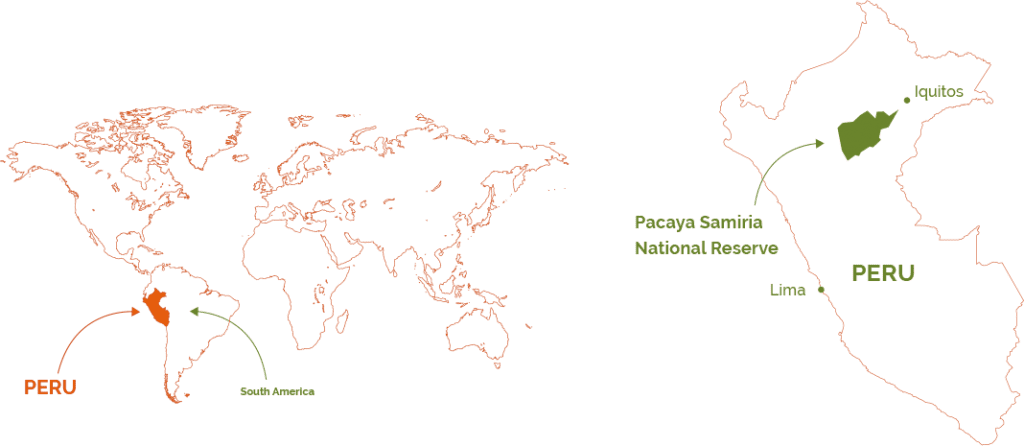The Destination
The Amazon Rainforest

Holding over one-half of the planet’s remaining rainforest, this astonishing ecosystem owes its existence to a truly life source: the Amazon River.
Rising in the Peruvian Andes, the Amazon River winds its way east over the northern part of South America until reaching the Atlantic Ocean. It carries into the Atlantic a higher volume of water than the earth’s top-10 largest rivers flowing into the ocean combined. Recent studies claims that the Amazon River is actually longer than the Nile by 65 miles; and researchers at the National Geographic Society have determined the source point of the river to be at Mount Mismi in Arequipa (in Southern Peru). Its “green treasures” are a wealth that hold great promises for Earth and mankind in the future.
The Pacaya Samiria National Reserve
Spanning more than 5 million acres, the Pacaya Samiria National Reserve is the largest protected flooded forest in the world.
Known also as the “mirror forest”, is one of the prime intact swaths of jungle in the Peruvian Amazon and the second largest national reserve in the country. During the rainy season in the Andes, water levels rise throughout all the rivers of Amazonia, flooding 85% of the reserve and making it only accessible by boat. Come the low water season, life regenerates in many fascinating ways, both flora and fauna, and the Pacaya Samiria becomes a place ideal for exploring by foot and otherwise. The national reserve is directly linked to the economic wellbeing of its resident populations. At least 100,000 ribereños –people who live along the riverbanks– rely on the rainforest’s aquatic and terrestrial resources for food and income.
Biodiversity
Over one third of all species recorded in the world are found in the Amazon Basin, constituting the largest collection of living plant and animal species on Earth.
As the largest tract of tropical rainforest in the Americas, the Amazonian rainforest boasts unparalleled biodiversity, and it has been estimated that many hundreds of million species may yet to be discovered. One in five of all birds recorded live in this extraordinary habitat. It also contains over 3,000 species of fresh-water fish, the largest amount in one area in the world with some being very impressive. For example, the paiche (also known as arapaima) may attain a length of up to 16 feet. And among mammals, lively dolphins, both grey and the rare pink species, are typically found in the Amazon’s tributaries and main rivers.
Local Communities
The Amazon Basin includes a diversity of traditional inhabitants, people who have lived in the rainforest for thousands of years and whose lifestyles and customs are well adapted to this environment.
Contrary to popular belief, the daily living of these communities does not significantly harm their home environment. Their work day is mostly occupied by subsistence activities such as fishing, small-scale agriculture, gathering and hunting. Their survival depends on their intimate relationship with their natural surroundings. Through various partnerships and humanitarian projects, Delfin and our travelers have helped these communities continue to develop and better, promoting a balance between their needs and those of the wildlife with which they share habitat and ecosystems.
Pink River Dolphins
There are times when life surprises us in different ways and fables become reality in the Amazon.
The Amazon and the tributaries hold ancient myths and legends. The Pink Dolphin is believed to have supernatural powers such as that of changing its appearance to that of a charming and handsome young man. They come from the river at night to seduce innocent women living by the shores and then make their way back into the river the next morning as a Pink Dolphin.
They are mostly found in slow moving river basins, streams and lakes with their flexible bodies stretching to 8 feet long and weighing up to 400 pounds.
Till recent times, dolphins and people who are living along the Amazon River coexisted in harmony with each other. But because of pollution and destruction of their habitat, they are still under threat of facing extinction.
Adapted from the book Journey of the Pink Dolphins: An Amazon Quest by Sy Montgomery (2009).